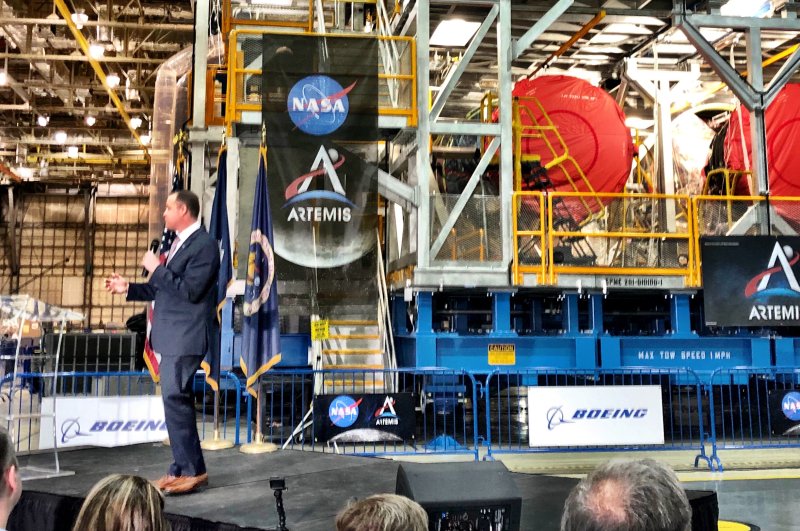1 of 3 | NASA Administrator Jim Bridenstine addresses a crowd in front of the new core stage of the Space Launch System rocket for the Artemis moon missions on Monday at NASA's Michoud Assembly Facility in Slidell, La. Photo by Paul Brinkmann/UPI
SLIDELL, La., Dec. 10 (UPI) -- NASA officially unveiled the core stage of its new Space Launch System moon rocket for planned Artemis missions at the Michoud Assembly Facility near New Orleans.
A day of speeches and praise for the workers also focused Monday on the astronomical cost of the program, which recently was estimated at $2 billion per rocket, according to the Office of Management and Budget.
NASA Administrator Jim Bridenstine said he believes the cost per rocket can be reduced if the space agency buys more of them.
"NASA estimates the cost of a single SLS rocket in a given year to be between about $800 million and$1.6 billion, depending on the total number of rockets in an order," Bridenstine said in a statement.
He added: "NASA is currently in negotiations with Boeing, the lead contractor for the development of SLS, to determine the appropriate number of rockets and costs to support the agency's exploration architecture."
The Artemis program as announced over the summer envisions multiple lunar missions to carry astronauts back to the moon to establish a permanent presence.
"The more we buy, the more the cost per unit comes down," Bridenstine said during his speech Monday. "We have to think about how many we're going to buy when we get ready to take the first rocket out of the facility and test it."
The rocket's giant core stage is in final testing in New Orleans before it is shipped to the space agency's main rocket testing facility, Stennis Space Center in southern Mississippi, in the next few weeks.
The core, or first stage, makes up two-thirds of the rocket at 212 feet tall with a diameter of 27.6 feet. It stores huge amounts of supercooled liquid hydrogen and liquid oxygen with four RS-25 engines. It's only meant to operate for a little more than eight minutes, reaching an altitude of 100 miles.
A second core stage for the Artemis 2 mission is being manufactured at Michoud. The Trump administration has set a goal of sending people back to the moon by 2024 on the Artemis 3 mission, but funding approval from Congress is uncertain.
Bridenstine said some parts of the mission can be fulfilled even without additional appropriations, but that's not what NASA would prefer. He said the agency has received approval for $2 billion in commercial lunar lander science missions.
The NASA administrator sidestepped a question about making lunar rockets reusable -- as SpaceX's Falcon Heavy rocket is, along with its next-generation Starship rocket under development.
Bridenstine said the Artemis program is designed to be much more sustainable than the Apollo moon program ever was. That's partly because NASA intends to build an orbiting lunar habitat, Gateway, that would stay there and help astronauts transition to lunar descent.
NASA and the administration have estimated the Artemis mission needs $20 billion to $30 billion to land on the moon by 2024.
"Apollo was not sustainable. The cost was too high because everything got thrown away on every mission," Bridenstine said. "We would like to see the Orion crew capsule have elements of it be reusable by Artemis."
SLS is the only rocket that is "human-rated," NASA's deputy administrator, James Morhard, said.
"We want the other guys, the private companies, to succeed because we want a menu of rockets to be able to use," he said.















